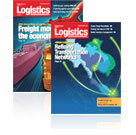Lift trucks: Over capacity and under-enforced
Lift truck capacity ratings are often misunderstood by owners, operators and even salespeople.
Latest Logistics News
USPS cites continued progress in fiscal second quarter earnings despite recording another net loss U.S. rail carload and intermodal volumes are mixed, for week ending May 4, reports AAR New Ryder analysis takes a close look at obstacles in converting to electric vehicles Norfolk Southern shareholders sign off on 10 board of directors nominees Inflation and economic worries are among top supply chain concerns for SMBs More NewsIn too many instances, managers and operators treat a lift truck’s load capacity like many drivers treat the speed limit—as a general guideline. According to Scott McLeod, president of Fleetman Consulting (604-614-3530, http://www.fleetmanconsulting.com), an independent lift truck consulting company, exceeding a lift truck’s load capacity can be both dangerous and easy, especially since ratings are poorly understood by buyers and inexperienced salespeople.
There are two types of capacity ratings, says McLeod. The first is the gross chassis capacity rating, the highest possible capacity under ideal conditions. “Ideal conditions” might include the absence of attachments like a side shift, an unelevated load, a two-stage mast instead of the more common three-stage mast, solid rubber tires instead of air-filled tires, and so on.
“Since lift trucks are rarely configured this way, this type of rating should only be used to compare lift truck brands,” says McLeod.
The second and more important rating is the net chassis capacity rating, or payload capacity. The net chassis capacity rating accounts for all of the options and specifications on a particular lift, and will reflect the payload capacity of the lift truck at full mast extension.
When asking a lift truck dealer for a quote on, say, a 5,000-pound capacity lift truck, it is important to specify whether that refers to net or gross capacity, says McLeod. It’s also important to describe the type, weight, evenness, and height of the truck’s current or anticipated loads.
Additionally, a 5,000-pound gross chassis capacity lift truck manufactured today will likely handle less payload weight than a 5,000-pound rated lift truck manufactured 25 years ago, says McLeod. Older lift trucks tend to have been built with greater safety margins, he says, and operators accustomed to older trucks often learn the hard way when they use newer equipment, even if the trucks have identical gross capacity ratings.
McLeod recommends mandatory lift truck scales, and ongoing education and discussions at safety meetings about loads and lift truck capacity.
“Unless you spend the time to better understand the weights and sizes of the loads you are handling and how they are to be handled,” says McLeod, “you can expect a degree of risk that an operator will have an accident with his lift truck because he made too many assumptions, either about the weights he was handling or the lift truck’s ability to handle the weight.”

Article Topics
Latest in Logistics
SKU vs. Item-level Data Visibility: Why it Matters for End-to-End Traceability Key benefits of being an Amazon Business customer with Business Prime USPS cites continued progress in fiscal second quarter earnings despite recording another net loss U.S. rail carload and intermodal volumes are mixed, for week ending May 4, reports AAR New Ryder analysis takes a close look at obstacles in converting to electric vehicles Norfolk Southern shareholders sign off on 10 board of directors nominees Between a Rock and a Hard Place More LogisticsAbout the Author
Subscribe to Logistics Management Magazine

Find out what the world's most innovative companies are doing to improve productivity in their plants and distribution centers.
Start your FREE subscription today.
May 2024 Logistics Management

Latest Resources














